-
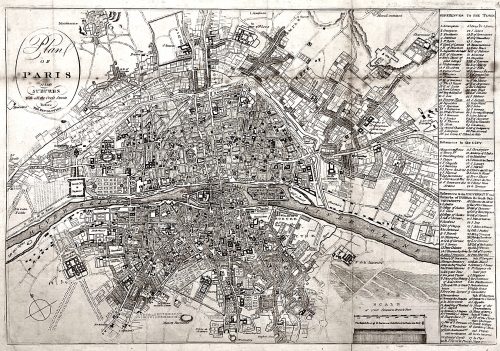 Oval cartouche in the upper-left corner, with tall “s”: Plan | OF | PARIS | and | SUBURBS | With all the Cross Streets | Before | THE REVOLUTION. || No indication of the makers. Dimensions: Sheet: 32.5 x 44.3 cm; Image: 28.5 x 41.3 cm.
Oval cartouche in the upper-left corner, with tall “s”: Plan | OF | PARIS | and | SUBURBS | With all the Cross Streets | Before | THE REVOLUTION. || No indication of the makers. Dimensions: Sheet: 32.5 x 44.3 cm; Image: 28.5 x 41.3 cm. -
 Artist: Utagawa Kuniyoshi [歌川 國芳] (Japanese, 1798 – 1861) Publisher: British Museum provides for the title as Enkyoku-zoroi [艶曲揃] (Set of Voluptuous Melodies) and the publisher as Sanpei. Indeed, 三平 (Sanpei) was a wholesale fan shop at the end of the Edo period. However, Andreas Marks identifies the publisher’s seal as 三平 Mihei = Mikawaya Heiroku (1848-56), a member of the Fan Producing Guild (AM 11-016|325a). Block carver: Hori Take [彫竹]
Artist: Utagawa Kuniyoshi [歌川 國芳] (Japanese, 1798 – 1861) Publisher: British Museum provides for the title as Enkyoku-zoroi [艶曲揃] (Set of Voluptuous Melodies) and the publisher as Sanpei. Indeed, 三平 (Sanpei) was a wholesale fan shop at the end of the Edo period. However, Andreas Marks identifies the publisher’s seal as 三平 Mihei = Mikawaya Heiroku (1848-56), a member of the Fan Producing Guild (AM 11-016|325a). Block carver: Hori Take [彫竹]Signed: Ichiyosai Kuniyoshi ga in a red cartouche and sealed with paulownia (kiri mon).
Date seal and double nanushi censor seals: Fuku & Muramatsu, 1853 (Kaei 6, 2nd month).
Size: Uchiwa-e (untrimmed fan print) 229 x 294 mm.
Provenance: The Collection of Paul F. Walter, Christie's, New York, 2017, lot 338; sold together with 10 other fan prints for $27,500. Before: Christie's, New York, 1994, lot 145 ($4,830). Ref: [LIB-1693.2018] The Collection of Paul Walter. — NY: Christie's, 2017, p. 361. Ref: Israel Goldman, Catalogue 2018, № 41: "Utagawa Kuniyoshi (1797-1861) A Woman on a Terrace Dancing with a Fan. From the series Enkyoku zoroi (Collection of Charming Music). 1853. Fan print. 22.9 x 29.4 cm. Provenance: Japanese Prints, Paintings and Screens, Christie's, New York, 1994, lot 145 ($4,830); The Collection of Paul F. Walter, Christie's, New York, 2017, lot 338. Fine impress." Known prints in this series:
SVJP-0251.2018
-
 Artist: Utagawa Kunisada [歌川 国貞] a.k.a. Utagawa Toyokuni III [三代歌川豊国] (Japanese, 1786 – 1865). Pubisher (accorfding to Suzuki & Oka): Ibaya Senzaburō [伊場屋仙三郎] (Japanese, 1815 – 1869), Dansendō [伊場仙]. Title: Beauty holding a roll of paper (by seller); A woman of Edo (by Suzuki & Oka) Date seal and aratame censor seal: 1822 (Bunsei 5). Signed: Gototei Kunisada ga [五渡亭国貞画]. Media: Untrimmed fan print (uchiwa-e), 228 x 295 mm. Ref: [LIB-3085.2022] Jūzō Suzuki, Isaburō Oka. “The decadents”. — Tokyo: Kodansha International, 1969, p. 35, plate 30: exactly this print:
Artist: Utagawa Kunisada [歌川 国貞] a.k.a. Utagawa Toyokuni III [三代歌川豊国] (Japanese, 1786 – 1865). Pubisher (accorfding to Suzuki & Oka): Ibaya Senzaburō [伊場屋仙三郎] (Japanese, 1815 – 1869), Dansendō [伊場仙]. Title: Beauty holding a roll of paper (by seller); A woman of Edo (by Suzuki & Oka) Date seal and aratame censor seal: 1822 (Bunsei 5). Signed: Gototei Kunisada ga [五渡亭国貞画]. Media: Untrimmed fan print (uchiwa-e), 228 x 295 mm. Ref: [LIB-3085.2022] Jūzō Suzuki, Isaburō Oka. “The decadents”. — Tokyo: Kodansha International, 1969, p. 35, plate 30: exactly this print:
-
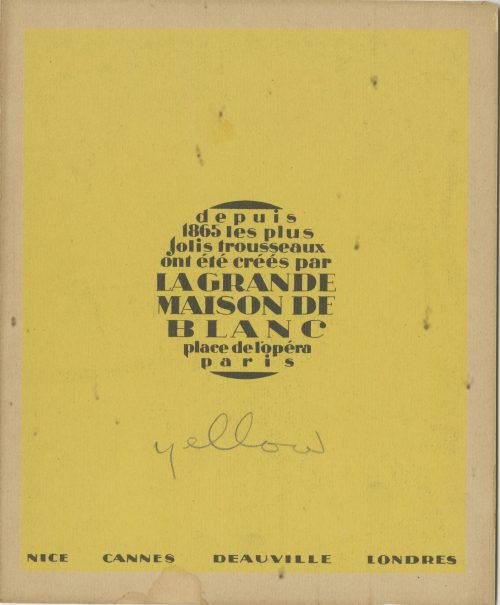 Four chromolithographic plates, each sheet 180 x 150 mm; image 16 x 12.5 cm after Feodor Rojankovsky, signed “Rojan”, titles printed on the back on red (à la chasse), blue (en voyage), green (aux courses), and yellow (depuis | 1865 les plus | jolis trousseaux | ont été créés par | LA GRANDE | MAISON DE | BLANC | place de l’opera | Paris | NICE CANNES DEAUVILLE LONDRES) background. Contributors: Feodor Rojankovsky [Rojan, Фёдор Степанович Рожанковский] (Russian-American, 1891 – 1970) – artist.
Four chromolithographic plates, each sheet 180 x 150 mm; image 16 x 12.5 cm after Feodor Rojankovsky, signed “Rojan”, titles printed on the back on red (à la chasse), blue (en voyage), green (aux courses), and yellow (depuis | 1865 les plus | jolis trousseaux | ont été créés par | LA GRANDE | MAISON DE | BLANC | place de l’opera | Paris | NICE CANNES DEAUVILLE LONDRES) background. Contributors: Feodor Rojankovsky [Rojan, Фёдор Степанович Рожанковский] (Russian-American, 1891 – 1970) – artist. -
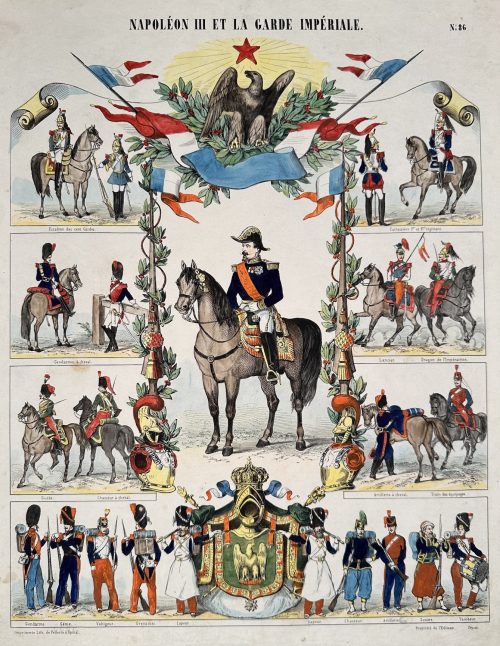 Hand-coloured woodcut on wove paper, 460 x 356 mm; black ink stamp “5055” to reverse. Top centre: "NAPOLÉON III ET LA GARDE IMPÉRIALE"; right: "№ 86". Napoléon III ahorseback in middle, beside (top to bottom): Escadron des cent Gardes — Cuirassiers 1er et 2me regiment; Gendarmes à cheval. — Lancier., Dragon de l’Impératrice.; Guide., Chasseur à cheval. — Artillerie à cheval, Train des équipages.; Gendarme. Génie. Voltigeur. Grenadier. Sapeur. Sapeur. Chasseur. Artillerie. Zouave. Tambour. Bottom left: Imprimerie Lith. de Pellerin à Épinal; right: Propriété de l’Éditeur. Déposé. Jean Charles Pellerin (French, 1756 – 1836) – printer/publisher.
Hand-coloured woodcut on wove paper, 460 x 356 mm; black ink stamp “5055” to reverse. Top centre: "NAPOLÉON III ET LA GARDE IMPÉRIALE"; right: "№ 86". Napoléon III ahorseback in middle, beside (top to bottom): Escadron des cent Gardes — Cuirassiers 1er et 2me regiment; Gendarmes à cheval. — Lancier., Dragon de l’Impératrice.; Guide., Chasseur à cheval. — Artillerie à cheval, Train des équipages.; Gendarme. Génie. Voltigeur. Grenadier. Sapeur. Sapeur. Chasseur. Artillerie. Zouave. Tambour. Bottom left: Imprimerie Lith. de Pellerin à Épinal; right: Propriété de l’Éditeur. Déposé. Jean Charles Pellerin (French, 1756 – 1836) – printer/publisher. -
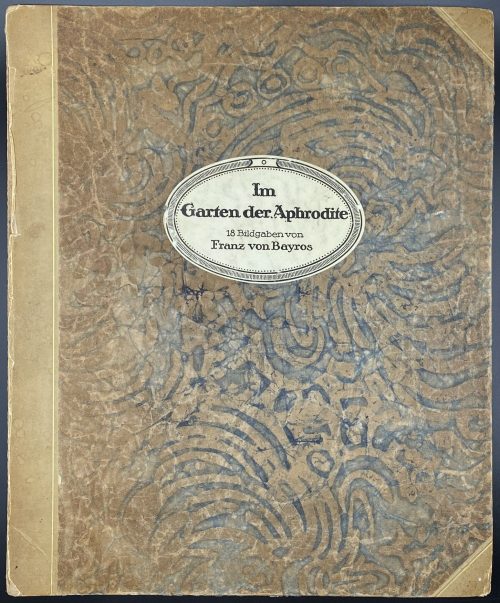 Cover with title: Im Garten der Aphrodite | 18 Bildgaben | von | Franz von Bayros | {vignette} | Privatdruck || in a frame; table of contents and limitation to verso; 18 plates with the drawings of Bayros in collotype reproduction, each mounted on cardboard and protected with the remnants of tissue guards, some lacking. Of the publisher’s folder, only the front board with an oval title label is present. Some images signed “Choisy le Conin” – von Bayros’s pseudonym. Two prints are missing: (1) Das Füßchen and (2) Die Liebesschaukel, the other 16 prints present. The vignette on the cover is a photomechanical reproduction. Edition: limited to 350 copies of which this is № 253. According to Christie’s: a collotype reprint, about twenty years after their first publication. English equivalent: The Garden of Aphrodite. Portfolio with 18 photogravures. Catalogue raisonné: The amorous drawings of the Marquis von Bayros (1968): pp. 177-1877; Bayros Zeichningen (1987): pp. 143-152.
Cover with title: Im Garten der Aphrodite | 18 Bildgaben | von | Franz von Bayros | {vignette} | Privatdruck || in a frame; table of contents and limitation to verso; 18 plates with the drawings of Bayros in collotype reproduction, each mounted on cardboard and protected with the remnants of tissue guards, some lacking. Of the publisher’s folder, only the front board with an oval title label is present. Some images signed “Choisy le Conin” – von Bayros’s pseudonym. Two prints are missing: (1) Das Füßchen and (2) Die Liebesschaukel, the other 16 prints present. The vignette on the cover is a photomechanical reproduction. Edition: limited to 350 copies of which this is № 253. According to Christie’s: a collotype reprint, about twenty years after their first publication. English equivalent: The Garden of Aphrodite. Portfolio with 18 photogravures. Catalogue raisonné: The amorous drawings of the Marquis von Bayros (1968): pp. 177-1877; Bayros Zeichningen (1987): pp. 143-152. -
 Artist: Utagawa Toyokuni I [歌川豊国] (1769–1825). Title: 「しなのやおこん 瀬川菊之丞」「帯屋長右衛門 嵐雛助」 Kabuki play: Katsuragawa Renri no Shigarami [桂川連理柵]. According to Waseda University Cultural Resource Database, the play was performed at Ichimura-za (Edo) on the 2nd month of Kansei 12 (year 1800) under the title 楼門五山桐 さんもんごさんのきり. Publisher: Nishimuraya Yohachi [西村屋与八] (Japanese, c. 1751 – 1869)., Play by Suga Sensuke [菅専助] (ca. 1728 – 1791) in two acts. First performed at Kita Horie-za in Osaka in October 1776. Based on a real incident occurring sometime in the Kyōhō era (1716-35), this story was first dramatized in 1761. The first Kabuki drama to stem from this play was in 1777 at Osaka's Araki-za. Obiya Chōemon, a married obi merchant (sitting with abacus) in his forties, meets his neighbour's daughter Ohan (standing behind Obiya), who is young enough to be his daughter, at an inn in Ishibe; the two fall in love and pledged their troth. Ohan becomes pregnant. After a series of misfortunes, the lovers rush to Katsuragawa (Katsura River), where they drown themselves.
Artist: Utagawa Toyokuni I [歌川豊国] (1769–1825). Title: 「しなのやおこん 瀬川菊之丞」「帯屋長右衛門 嵐雛助」 Kabuki play: Katsuragawa Renri no Shigarami [桂川連理柵]. According to Waseda University Cultural Resource Database, the play was performed at Ichimura-za (Edo) on the 2nd month of Kansei 12 (year 1800) under the title 楼門五山桐 さんもんごさんのきり. Publisher: Nishimuraya Yohachi [西村屋与八] (Japanese, c. 1751 – 1869)., Play by Suga Sensuke [菅専助] (ca. 1728 – 1791) in two acts. First performed at Kita Horie-za in Osaka in October 1776. Based on a real incident occurring sometime in the Kyōhō era (1716-35), this story was first dramatized in 1761. The first Kabuki drama to stem from this play was in 1777 at Osaka's Araki-za. Obiya Chōemon, a married obi merchant (sitting with abacus) in his forties, meets his neighbour's daughter Ohan (standing behind Obiya), who is young enough to be his daughter, at an inn in Ishibe; the two fall in love and pledged their troth. Ohan becomes pregnant. After a series of misfortunes, the lovers rush to Katsuragawa (Katsura River), where they drown themselves.Segawa Kikunojō III (Japanese, 1751 – 1810); other names: Segawa Senjo, Segawa Rokō III, Segawa Tomisaburō I, Ichiyama Tomisaburō, Ichiyama Shichinosuke. The actor held the name of Segawa Kikunojō III from the 11th lunar month of 1774 to the 7th lunar month of 1801. He surpassed all the actors of his time in both female and male roles, especially in the former, and achieved tremendous public acclaim.
Arashi Hinasuke II [嵐雛助] (Japanese, c. 1774 – 1801); other names: Nakamura Jūzō III, Kanō Hidenosuke I, Arashi Hidenosuke I. The actor held the name of Arashi Hinasuke II from the 1st lunar month of 1794 to the 2nd lunar month of 1801. Hi died in Edo on the 4th day of the 2nd lunar month of 1801. For the same characters illustrated by Utagawa Kuniyoshi see SVJP-0333.2021. Sources:
Sources:
- Historical Dictionary of Japanese Traditional Theatre By Samuel L. Leiter. Second edition, 2014.
- Kabuki Encyclopedia. An English-Langauge Adaptation of Kabuki Jiten. Samuel L. Leiter. Greenwood Press, 1979.
- http://www.kabuki21.com/
- Waseda University Cultural Resource Database
-
 Kikukawa Eizan (菊川 英山, 1787 – July 17, 1867) Signed: Eizan hitsu (英山筆)
Kikukawa Eizan (菊川 英山, 1787 – July 17, 1867) Signed: Eizan hitsu (英山筆)Jacob Pins #972/p.341. Leiden, Rijksmuseum voor Volkenkunde.
"The Lovers Miura-ya Komurasaki and Shirai Gonpachi: Tragic love stories taken from real life and dramatized were a staple of stage and print; the darkly romantic combination of desire and death was hugely popular in the eighteenth century. Hirai Gompachi was a warrior of the Tottori fief in western Japan who fled to Edo after committing a murder. He was apprehended and sentenced to death in 1679. His distraught lover, the courtesan Komurasaki, committed suicide at his grave." [MET]
.
-
 Title: Eleventh lunar month (Chuto no zu); Series: Fashionable Twelve Months (Imayo juni-kagetsu). Another version of translation: Modern Beauties of Twelve Months. Artist: Utagawa Toyokuni I [歌川豊国] (1769–1825). Pubisher: Ibaya Senzaburō [伊場屋仙三郎] (Japanese, 1815 – 1869), seal: Dansendō [伊場仙]. Signed: Toyokuni ga and sealed with toshidama. Date-kiwame seal: Ushi (ox), Bunsei 5 (1822). Size: double-sheet uncut fan print ( aiban uchiwa-e), 219 x 295 mm.
Title: Eleventh lunar month (Chuto no zu); Series: Fashionable Twelve Months (Imayo juni-kagetsu). Another version of translation: Modern Beauties of Twelve Months. Artist: Utagawa Toyokuni I [歌川豊国] (1769–1825). Pubisher: Ibaya Senzaburō [伊場屋仙三郎] (Japanese, 1815 – 1869), seal: Dansendō [伊場仙]. Signed: Toyokuni ga and sealed with toshidama. Date-kiwame seal: Ushi (ox), Bunsei 5 (1822). Size: double-sheet uncut fan print ( aiban uchiwa-e), 219 x 295 mm.

-
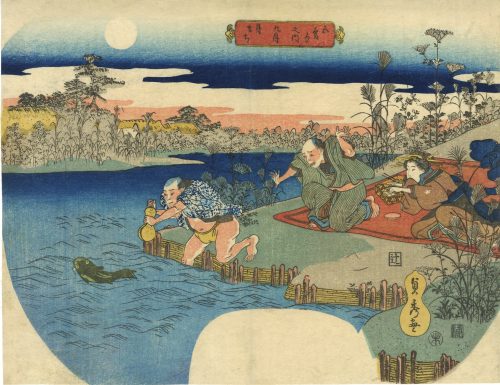 Artist: Utagawa Sadahide [歌川貞秀] (Japanese, 1807 – 1879). Publisher: Iseya Ichiemon [伊勢屋市右衛門] (Japanese, fl. c. 1820s – c. 1860s). Size: Uncut fan print (uchiwa-e), 220 x 285 mm. Date-kiwame seal: 1835 (Tenpō 6). Signed: Sadahide ga in a double-gourd cartouche. Man trying to catch a catfish with a gourd during a picnic on an autumn evening. Five Festivals [五節句の內] (Gosekku no uchi), Ninth Month [九月] (Kugatu), Full moon celebration on the 15th night of the month (Tsuki machi) [月まち] or [月待]. The autumnal spirit is also supported by the presence of Patrinia scabiosifolia (ominaeshi) [女郎花] and Miscanthus sinensis, or Japanese pampas grass (susuki) [薄]. These two are part of the Seven Grasses of Autumn (aki no nanakusa) [秋の七草]. Description by Richard Kruml: "Viewing the full moon in the eighth and ninth months was a popular activity passed down from the aristocracy in Heian times; especially where the moon's reflection could be seen in the water. One such party is seen here where a member vainly attempts to catch a catfish with a gourd: A hopeless task with such an unsuitable utensil. This is based on a Zen riddle posed by the shōgun Ashikaga Yoshimochi [足利 義持] (Japanese, 1386 – 1428) on how to catch a catfish with a gourd, which inspired the 15th-century artist Josetsu [如拙] (Japanese, fl. 1405 – 1496) to paint the subject with accompanying poems on the conundrum by Zen monks".
Artist: Utagawa Sadahide [歌川貞秀] (Japanese, 1807 – 1879). Publisher: Iseya Ichiemon [伊勢屋市右衛門] (Japanese, fl. c. 1820s – c. 1860s). Size: Uncut fan print (uchiwa-e), 220 x 285 mm. Date-kiwame seal: 1835 (Tenpō 6). Signed: Sadahide ga in a double-gourd cartouche. Man trying to catch a catfish with a gourd during a picnic on an autumn evening. Five Festivals [五節句の內] (Gosekku no uchi), Ninth Month [九月] (Kugatu), Full moon celebration on the 15th night of the month (Tsuki machi) [月まち] or [月待]. The autumnal spirit is also supported by the presence of Patrinia scabiosifolia (ominaeshi) [女郎花] and Miscanthus sinensis, or Japanese pampas grass (susuki) [薄]. These two are part of the Seven Grasses of Autumn (aki no nanakusa) [秋の七草]. Description by Richard Kruml: "Viewing the full moon in the eighth and ninth months was a popular activity passed down from the aristocracy in Heian times; especially where the moon's reflection could be seen in the water. One such party is seen here where a member vainly attempts to catch a catfish with a gourd: A hopeless task with such an unsuitable utensil. This is based on a Zen riddle posed by the shōgun Ashikaga Yoshimochi [足利 義持] (Japanese, 1386 – 1428) on how to catch a catfish with a gourd, which inspired the 15th-century artist Josetsu [如拙] (Japanese, fl. 1405 – 1496) to paint the subject with accompanying poems on the conundrum by Zen monks". -
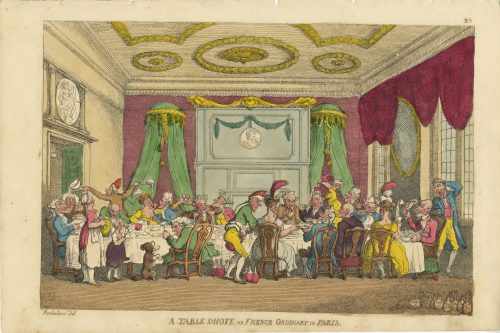 Hand-coloured etching by Thomas Rowlandson, printed on May 30, 1810, in London; № 20 from the series The Caricature Magazine or Hudibrastic Mirror Vol. 2. Description by Metropolitan Museum (59.533.978): "Guests of a dinner sit at a long narrow table in a magnificent room with an ornate ceiling. Two men and a young woman serve wine, one drawing a cork, the others spilling wine over the guests. Another waiter spills soup in an elderly guest's face. A woman and a little girl with a begging dog play tambourine and triangle at left." Inscribed in plate lower left: "Rowlandson Del."; bottom centre: "A TABLE DHOTE, OR FRENCH ORDINARY IN PARIS." Our copy is lacking the publication details: "Pub.d May 30. 1810 by Tho.s Tegg 111 Cheapside, London." and similar to the copy in Boston Public Library (18_03_000394). Dimensions: Sheet 27 x 40.5 cm; Image: 23.5 x 35 cm. Contributors: Thomas Rowlandson (British, 1756 – 1827) – artist. Thomas Tegg (British, 1776 – 1846) – publisher.
Hand-coloured etching by Thomas Rowlandson, printed on May 30, 1810, in London; № 20 from the series The Caricature Magazine or Hudibrastic Mirror Vol. 2. Description by Metropolitan Museum (59.533.978): "Guests of a dinner sit at a long narrow table in a magnificent room with an ornate ceiling. Two men and a young woman serve wine, one drawing a cork, the others spilling wine over the guests. Another waiter spills soup in an elderly guest's face. A woman and a little girl with a begging dog play tambourine and triangle at left." Inscribed in plate lower left: "Rowlandson Del."; bottom centre: "A TABLE DHOTE, OR FRENCH ORDINARY IN PARIS." Our copy is lacking the publication details: "Pub.d May 30. 1810 by Tho.s Tegg 111 Cheapside, London." and similar to the copy in Boston Public Library (18_03_000394). Dimensions: Sheet 27 x 40.5 cm; Image: 23.5 x 35 cm. Contributors: Thomas Rowlandson (British, 1756 – 1827) – artist. Thomas Tegg (British, 1776 – 1846) – publisher. -
 Artist: Utagawa Kunisada [歌川 国貞] a.k.a. Utagawa Toyokuni III [三代歌川豊国] (Japanese, 1786 – 1865). Signed: Kunisada ga [国貞画] in a red double-gourd cartouche Publisher: Unknown (no seal). Date: c. 1832 Izzard: "... red cloth decorated with the characters Yauan, one of Ichikawa Danjūrō VII [市川団十郎] (Japanese, 1791 – 1859) poetry names, and the name of his residence in Fukagawa. The absence of publisher's emblem and censorship seals may indicate that this was a privately issued print, not for public use". Ref.: [LIB-2967.2022] Utagawa Kunisada (1786 – 1865): His world revisited / Catalogue № 17, Exhibition March 17-21, 2021. — NY: Sebastian Izzard, LLC., 2021; p. 112-3, fig. 32). Size: Fan print (aiban uchiwa-e); 235 x 295 mm.
Artist: Utagawa Kunisada [歌川 国貞] a.k.a. Utagawa Toyokuni III [三代歌川豊国] (Japanese, 1786 – 1865). Signed: Kunisada ga [国貞画] in a red double-gourd cartouche Publisher: Unknown (no seal). Date: c. 1832 Izzard: "... red cloth decorated with the characters Yauan, one of Ichikawa Danjūrō VII [市川団十郎] (Japanese, 1791 – 1859) poetry names, and the name of his residence in Fukagawa. The absence of publisher's emblem and censorship seals may indicate that this was a privately issued print, not for public use". Ref.: [LIB-2967.2022] Utagawa Kunisada (1786 – 1865): His world revisited / Catalogue № 17, Exhibition March 17-21, 2021. — NY: Sebastian Izzard, LLC., 2021; p. 112-3, fig. 32). Size: Fan print (aiban uchiwa-e); 235 x 295 mm. -
 Utagawa Kunisada [歌川 国貞]; a.k.a. Utagawa Toyokuni III [三代歌川豊国] (Japanese, 1786 – 1865). Signed: Toyokuni ga [豊国 画] in a yellow toshidama cartouche. Publisher: Unknown, seal [久] Kyū (Japanese, fl. c. 1851 – 1861); (Marks 07-023 | U176a, possibly Sagamia Kyūzō). Date seal and double nanushi censor seals: Fuku & Muramatsu, Kaei 6, 2nd month (2/1853). Inscription in a red cartouche: (Purple of Edo // Purple of the Bay Capital) [江都むらさき] (Edo Murasaki), alluding to Murasaki Shikibu [紫 式部] (Japanese, c. 973/8 – c. 1014/31), the author of Genji Monogatari [源氏物語] (The Tale of Genji), a Heian period novel which was the source of a parody Nise Murasaki Inaka Genji [偐紫田舎源氏] (Fake Murasaki’s Rustic Genji) by Ryutei Tanehiko [柳亭種彦] (Japanese, 1783 – 1842). According to Horst Graebner: The actor is Ichikawa Danjūrō VIII. Ichikawa Danjūrō VIII [市川団十郎] (Japanese, 1823 – 1854); other names: Ichikawa Ebizō VI, Ichikawa Shinnosuke II. One of the series of Kunisada’s fan prints in this collection:
Utagawa Kunisada [歌川 国貞]; a.k.a. Utagawa Toyokuni III [三代歌川豊国] (Japanese, 1786 – 1865). Signed: Toyokuni ga [豊国 画] in a yellow toshidama cartouche. Publisher: Unknown, seal [久] Kyū (Japanese, fl. c. 1851 – 1861); (Marks 07-023 | U176a, possibly Sagamia Kyūzō). Date seal and double nanushi censor seals: Fuku & Muramatsu, Kaei 6, 2nd month (2/1853). Inscription in a red cartouche: (Purple of Edo // Purple of the Bay Capital) [江都むらさき] (Edo Murasaki), alluding to Murasaki Shikibu [紫 式部] (Japanese, c. 973/8 – c. 1014/31), the author of Genji Monogatari [源氏物語] (The Tale of Genji), a Heian period novel which was the source of a parody Nise Murasaki Inaka Genji [偐紫田舎源氏] (Fake Murasaki’s Rustic Genji) by Ryutei Tanehiko [柳亭種彦] (Japanese, 1783 – 1842). According to Horst Graebner: The actor is Ichikawa Danjūrō VIII. Ichikawa Danjūrō VIII [市川団十郎] (Japanese, 1823 – 1854); other names: Ichikawa Ebizō VI, Ichikawa Shinnosuke II. One of the series of Kunisada’s fan prints in this collection: -
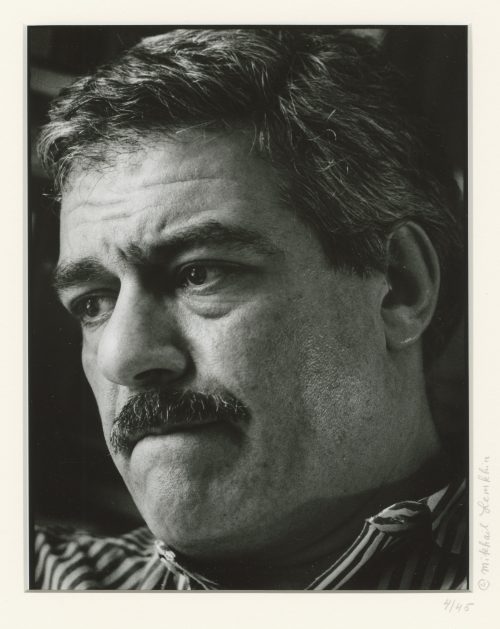 Photographic portrait of writer Andrei Sinyavsky, head and shoulder, turned to the left, wearing glasses. Pencil-signed on the mat: 4/45 • ©Mikhail Lemkhin; on the back of the print: Copyright statement stamp; ink stamp ©MIKHAIL LEMKHIN; ink stamp: PHOTO BY MIKHAIL LEMKHIN | 1811 38TH AVENUE | SAN FRANCISCO, CA 94122 | (415) 664-7677; pencil inscription on the back of the mat: (top) АНДРЕЙ СИНЯВСКИЙ | ANDREI SINYAVSKY, (bottom) XXIX. Size: mat: 43.2 x 35.5 cm; window: 23.5 x 18.5 cm; print: 25.2 x 20.2 cm. Limited edition of 45, of which this is № 4, signed and stamped by the artist. Sitter: Sergei Dovlatov [Сергей Донатович Довлатов] (Russian, 1941 – 1990)
Photographic portrait of writer Andrei Sinyavsky, head and shoulder, turned to the left, wearing glasses. Pencil-signed on the mat: 4/45 • ©Mikhail Lemkhin; on the back of the print: Copyright statement stamp; ink stamp ©MIKHAIL LEMKHIN; ink stamp: PHOTO BY MIKHAIL LEMKHIN | 1811 38TH AVENUE | SAN FRANCISCO, CA 94122 | (415) 664-7677; pencil inscription on the back of the mat: (top) АНДРЕЙ СИНЯВСКИЙ | ANDREI SINYAVSKY, (bottom) XXIX. Size: mat: 43.2 x 35.5 cm; window: 23.5 x 18.5 cm; print: 25.2 x 20.2 cm. Limited edition of 45, of which this is № 4, signed and stamped by the artist. Sitter: Sergei Dovlatov [Сергей Донатович Довлатов] (Russian, 1941 – 1990) -
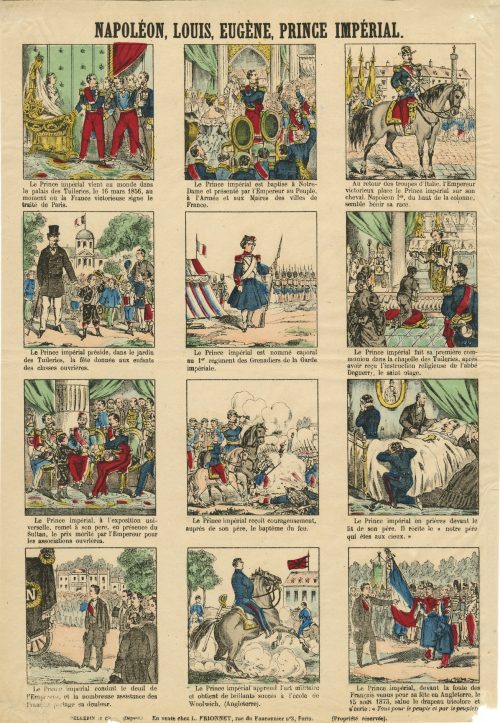 Hand-coloured woodcut on wove paper, 400 x 277 mm. Top: "NAPOLÉON, LOUIS, EUGÈNE, PRINCE IMPÉRIAL"; bellow 12 captioned frames:
Hand-coloured woodcut on wove paper, 400 x 277 mm. Top: "NAPOLÉON, LOUIS, EUGÈNE, PRINCE IMPÉRIAL"; bellow 12 captioned frames:- Le Prince impérial vient au monde dans le palais des Tuileries, le 16 mars 1856, au moment où la France victorieuse signe le traité de Paris.
- Le Prince impérial est baptisé à Notre-Dame et présenté par l'Empereur au Peuple, à l’Armée et aux Maires des villes de France.
- Au retour des troupes d'Italie, l'Empereur victorieux place le Prince impérial sur son cheval. Napoléon Ier, du haut de la colonne, semble bénir sa race.
- Le Prince impérial préside, dans le jardin des Tuileries, la fête donnée aux enfants des classes ouvrières.
- Le Prince impérial est nommé caporal au 1er régiment des Grenadiers de la Garde impériale.
- Le Prince impérial fait sa première communion dans la chapelle des Tuileries, après avoir reçu l'instruction religieuse de l'abbé Deguerry, le saint otage.
- Le Prince impérial, à l'exposition universelle, remet à son père. en présence du Sultan, le prix mérité par l'Empereur pour les associations ouvrières.
- Le Prince impérial reçoit courageusement, auprès de son père, le baptême du feu.
- Le Prince impérial en prières devant le lit de son père. Il récite le « notre père qui ètes aux cieux. »
- Le Prince impérial conduit le deuil de l'Empereur, et la nombreuse assistance des Français portage sa douleur.
- Le Prince impérial apprend l’art militaire et obtient de brillants succès à l'écolo de Woolwich, (Angleterre).
- Le Prince impérial, devant la foule des Français venus pour sa fête en Angleterre, le 15 out 1873, salue le drapeau tricolore et s'écrie : « Tout pour le peuple et par le peuple… »
-
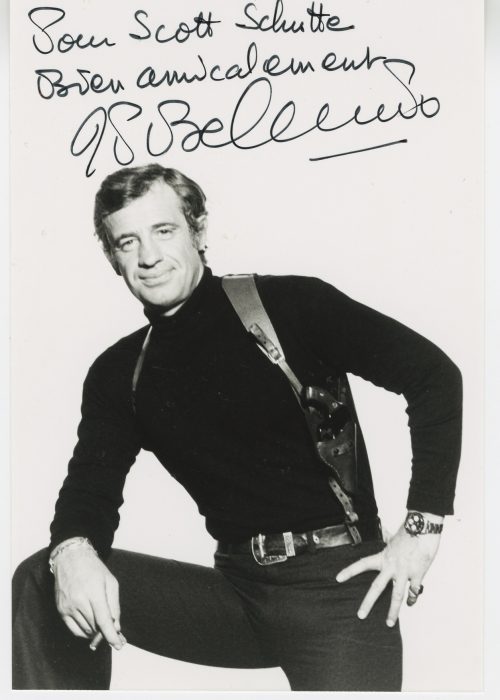 Three-quarter waist portrait of French actor Jean-Paul Belmondo in the film Peur sur la Ville, directed by Henri Verneuil in 1975. Autographed in black ink on a light area of the image above the head: “Pour Scott Schutte | Bien amicalement | J.P. Belmondo”. Paper watermarked "Agfa" in a diamond. Dimensions: 147 x 100 mm
Three-quarter waist portrait of French actor Jean-Paul Belmondo in the film Peur sur la Ville, directed by Henri Verneuil in 1975. Autographed in black ink on a light area of the image above the head: “Pour Scott Schutte | Bien amicalement | J.P. Belmondo”. Paper watermarked "Agfa" in a diamond. Dimensions: 147 x 100 mm -
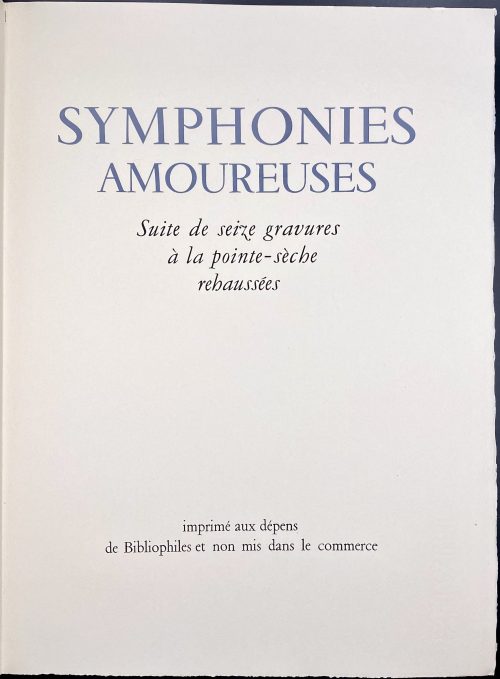 Description: Suite of 16 hand-coloured drypoints, in 39 x 29 cm, in cream French flapped wrappers with lavender lettering “SYMPHONIES AMOUREUSES” and a sanguine drypoint vignette (platemark 15 x 13 cm) to front, 17 leaves plus 2 leaves in the wrappers, 38.5 x 57 cm vertically folded once, lettering to one page, plate to another page, unbound, only the top margin trimmed, unpaginated, wove paper watermarked "BFK Rives", in a faux chagrin double slipcase 39.8 x 30 cm. Title-page (in lavender and black): SYMPHONIES AMOUREUSES | Suite de seize gravures | à la pointe sèche | rehaussées | {blank} | imprimé aux dépens | de Bibliophiles et non mis dans le commerce || Titles of the plates : 1. Ouverture. 2. Gamme. 3. Rêverie. 4. Pas redoublé. 5 Fantasia. 6. Pastorale. 7. Estudiantina. 8. Presto. 9. Arpège. 10. Menuet. 11 .Symphonie médiévale. 12. Jeux d’eau. 13. Galop. 14. Impromptu. 15. Variation. 16. Ariette. Limitation: Print run of 100 copies, 5 copies on Japon Manchou, numbered №№ 1-5, enriched; 11 copies on vélin à la forme de Rives, numbered №№ 6-16, enriched; 84 copies on vélin à la forme de Rives, numbered №№ 17-100, of which this is copy № 32. Cat. raisonné: Dutel III, № 2478. Contributors: André Collot (French, 1897 – 1976) – artist, engraver.
Description: Suite of 16 hand-coloured drypoints, in 39 x 29 cm, in cream French flapped wrappers with lavender lettering “SYMPHONIES AMOUREUSES” and a sanguine drypoint vignette (platemark 15 x 13 cm) to front, 17 leaves plus 2 leaves in the wrappers, 38.5 x 57 cm vertically folded once, lettering to one page, plate to another page, unbound, only the top margin trimmed, unpaginated, wove paper watermarked "BFK Rives", in a faux chagrin double slipcase 39.8 x 30 cm. Title-page (in lavender and black): SYMPHONIES AMOUREUSES | Suite de seize gravures | à la pointe sèche | rehaussées | {blank} | imprimé aux dépens | de Bibliophiles et non mis dans le commerce || Titles of the plates : 1. Ouverture. 2. Gamme. 3. Rêverie. 4. Pas redoublé. 5 Fantasia. 6. Pastorale. 7. Estudiantina. 8. Presto. 9. Arpège. 10. Menuet. 11 .Symphonie médiévale. 12. Jeux d’eau. 13. Galop. 14. Impromptu. 15. Variation. 16. Ariette. Limitation: Print run of 100 copies, 5 copies on Japon Manchou, numbered №№ 1-5, enriched; 11 copies on vélin à la forme de Rives, numbered №№ 6-16, enriched; 84 copies on vélin à la forme de Rives, numbered №№ 17-100, of which this is copy № 32. Cat. raisonné: Dutel III, № 2478. Contributors: André Collot (French, 1897 – 1976) – artist, engraver. -
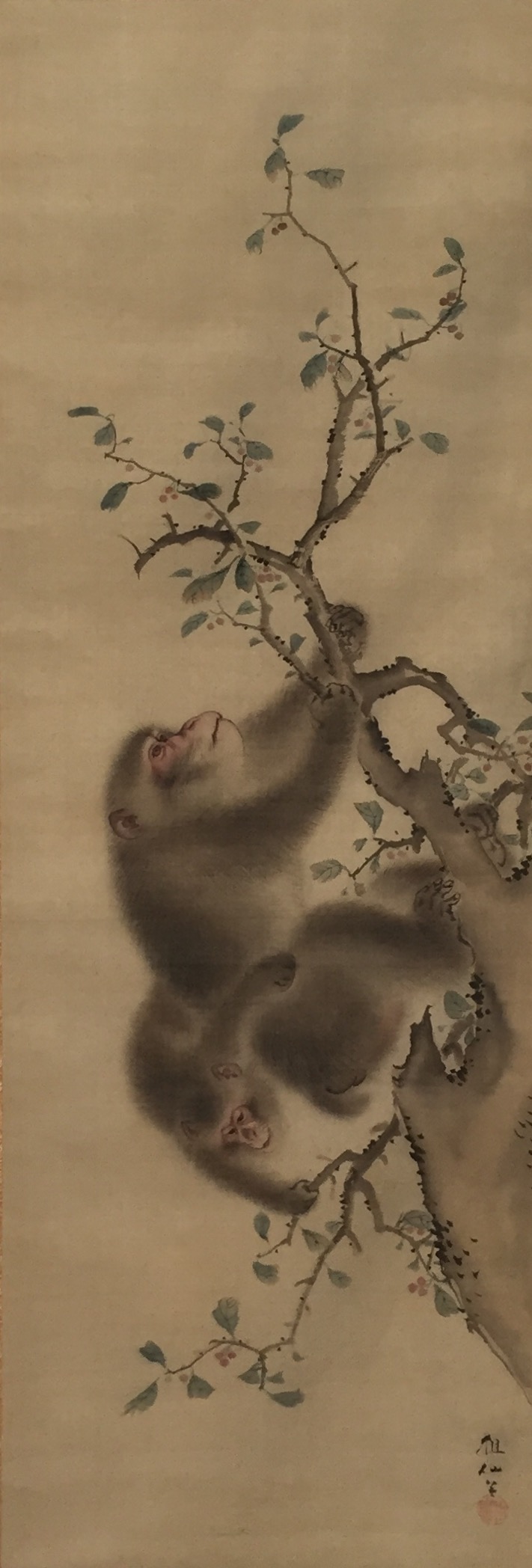 Mori Sosen (1747-1821). Two Monkeys Hanging From Branches. Hanging Scroll Painting. Ink and colour on silk. Signed: Sosen. Sealed: Sosen.
Mori Sosen (1747-1821). Two Monkeys Hanging From Branches. Hanging Scroll Painting. Ink and colour on silk. Signed: Sosen. Sealed: Sosen.








